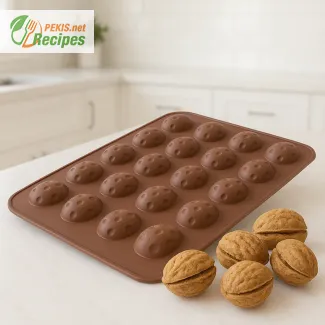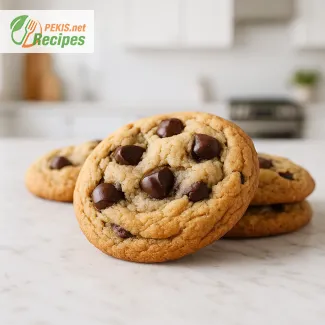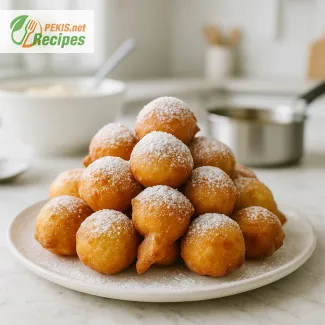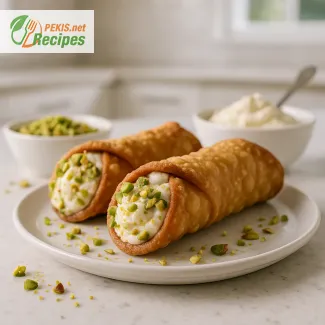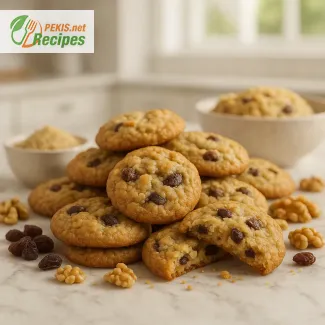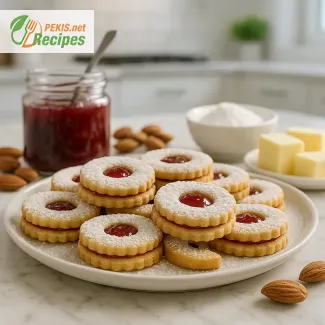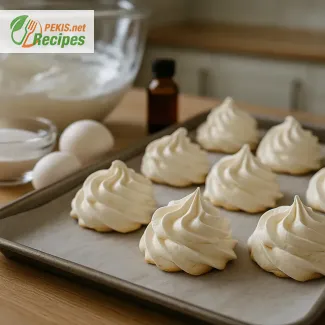
A timeless dessert with irresistible crunch and sweetness
The delicate art of making the perfect meringue cookie
There is something utterly magical about a meringue. With just a few simple ingredients—egg whites and sugar—this classic treat transforms into a cloud-like creation with a crisp, airy texture and a melt-in-the-mouth sweetness that has enchanted generations of dessert lovers. The meringue cookie is more than just a treat; it’s a showcase of technique, patience, and elegance. With a perfect balance between crunch and delicacy, these cookies are beloved around the world, especially during the holidays or as a light finish to a rich meal.
The charm of crispy egg white cookies lies not only in their texture but in their versatility. Whether served on their own, paired with fresh berries and cream, or crumbled over ice cream, meringues add a luxurious and sophisticated touch to any dessert spread. Their pristine white hue and glossy exterior give them a refined appearance, making them just as fitting on a wedding dessert table as they are in a cozy kitchen setting.
At the heart of a great meringue recipe is the ability to whip egg whites into stiff peaks that hold their shape, creating that signature puffed-up, glossy form. Achieving this ideal texture is as much about understanding your ingredients as it is about mastering the technique. When done right, the result is a batch of perfectly crisp meringue cookies that are featherlight on the outside and delicately chewy in the center.
What makes this recipe truly shine is its consistency. It’s reliable enough for beginners to try without hesitation, and yet satisfying enough for experienced bakers to perfect and personalize. With just a handful of ingredients and a little patience in the oven, you can create a dessert that’s both gluten-free and naturally elegant. And with the growing interest in simple homemade desserts, this classic treat is experiencing a resurgence in popularity.
Beyond their enchanting texture and sweetness, meringues are also incredibly versatile in flavor. A hint of vanilla, a dash of lemon zest, or a sprinkle of crushed nuts can transform this basic recipe into something entirely your own. You can even tint them with natural food coloring to match a festive theme or swirl them with a bit of cocoa for an eye-catching marbled effect. Whether you’re crafting these cookies for a special occasion or as a sweet surprise for someone you love, meringue cookies always make a lasting impression.
Another reason these egg white cookies remain a favorite is their long shelf life. When stored in an airtight container, they stay crisp for days, making them an ideal make-ahead dessert or gift. Their weightless structure and delicate appearance also make them a popular choice for cookie boxes and dessert platters, where they add contrast and charm among heavier baked goods.
This meringue recipe is the ultimate foundation for creative expression. Once you’ve mastered the base, the variations are endless: pipe them into star shapes, sandwich them with chocolate ganache, or crumble them into Eton mess. The only limit is your imagination.
As baking trends continue to celebrate simplicity, authenticity, and elegance, meringues offer all three. They may seem fragile, but their presence on a dessert plate is bold and unforgettable. Whether you’re looking for a light gluten-free dessert, a delicate cookie to enjoy with tea, or a sophisticated addition to your holiday baking, this recipe for crispy egg white cookies will exceed your expectations.
Let’s dive into how you can create these airy, crunchy meringue cookies at home with precision and style.
- Preheat the oven to 90°C (195°F) and line a baking sheet with parchment paper. Make sure the oven is not too hot, as low and slow is key to achieving crisp meringues.
- Clean the bowl and beaters thoroughly to ensure there is no grease, which can prevent the egg whites from whipping properly. Use a stainless steel or glass bowl for best results.
- Separate the egg whites from the yolks, ensuring no yolk is mixed in. Place the egg whites in the bowl and let them sit at room temperature for 10–15 minutes. This helps them whip better.
- Beat the egg whites on medium speed until they become foamy and start to hold soft peaks.
- Gradually add the sugar, one tablespoon at a time, beating continuously. Continue beating until stiff, glossy peaks form. The mixture should feel smooth between your fingers, with no graininess from the sugar.
- Add cornstarch, vinegar, vanilla, and salt, and beat for an additional 30 seconds to combine. These ingredients stabilize the meringue and add flavor.
- Spoon or pipe the meringue onto the prepared baking sheet, leaving space between each cookie. Use a piping bag for a decorative finish or a spoon for rustic drops.
- Bake the meringues for 90 minutes. Do not open the oven during baking. After baking, turn off the oven and leave the meringues inside to cool completely for at least 1 hour. This prevents cracking and ensures even drying.
- Once cool, gently remove the meringues from the baking paper. Store in an airtight container at room temperature to keep them crisp.
Creative variations and healthier upgrades for a classic meringue
Tips for enhancing flavor, texture, and presentation of homemade egg white cookies
While the classic meringue recipe is undeniably elegant in its simplicity, there are many ways to elevate this dessert into something even more memorable. Whether you're looking to enhance the flavor, refine the texture, or introduce a healthier twist, small adjustments can significantly transform the final result. The beauty of homemade meringue cookies is not just in their crisp shell and airy interior but also in their adaptability. From aromatic infusions to natural sweetener alternatives, the possibilities are rich and rewarding.
The impact of ingredient upgrades
One of the most effective ways to improve a traditional meringue recipe is by upgrading the quality of your ingredients. Using organic eggs can subtly influence the flavor, giving the cookies a cleaner, more wholesome taste. For an aromatic boost, replace standard vanilla extract with vanilla bean paste or scraped fresh vanilla seeds. This not only enhances the aroma but also adds visual flair with specks of real vanilla in every bite.
Adding a pinch of cream of tartar (around 1 g / ¼ tsp) to your egg whites during the whipping stage can greatly increase the stability of the meringue. It helps maintain stiff peaks and prevents the sugar from weeping out during baking. If cream of tartar is not available, a few drops of lemon juice will achieve a similar effect, while also imparting a gentle citrus note.
For those seeking a slightly richer flavor profile, try incorporating a dusting of finely ground nuts, such as toasted hazelnuts or almonds. Fold them gently into the meringue just before piping. This introduces a layer of complexity and provides a lovely contrast between the nutty crunch and the meringue’s lightness.
Flavor variations and creative additions
Meringue cookies provide a blank canvas for creative flavor combinations. Here are several delicious options:
- Cocoa powder: Sift in 10 g (1 tbsp) of high-quality cocoa powder for a subtle chocolate undertone and a visual twist. It turns the meringue a soft beige while deepening the flavor.
- Espresso powder: A pinch (about 1 g) intensifies the sweetness and adds depth, perfect for coffee lovers.
- Citrus zest: Grated zest of lemon, lime, or orange can provide a refreshing counterpoint to the sugary base.
- Spices: Cinnamon, cardamom, or ground ginger can be added in tiny amounts to give your meringues a seasonal flair.
You can also pipe the meringues into unique shapes or even create meringue nests for filling with cream and fruit. This adds both visual appeal and versatility, turning a simple cookie into an elegant plated dessert.
Why homemade is better
Store-bought meringues often contain preservatives, artificial flavors, and stabilizers that can affect both taste and texture. In contrast, homemade meringues are fresh, free from additives, and customizable. You can control the level of sweetness, adjust the size of each cookie, and experiment with shapes, colors, and flavors. Additionally, making them at home offers a greater connection to the craft of baking, where attention to detail produces results that are as rewarding as they are delicious.
Another benefit is freshness. Meringues begin to absorb moisture from the air the moment they're exposed, which compromises their crispness. Homemade versions can be baked and stored properly for guaranteed freshness and crunch.
Common mistakes and how to avoid them
Even a simple recipe like meringue can be prone to error. Understanding these pitfalls can help ensure consistent success:
- Egg whites not properly separated: Even a small amount of yolk can prevent stiff peaks from forming. Always separate eggs in a separate bowl before combining.
- Using a plastic bowl: Plastic can retain grease, which hinders whipping. Choose metal or glass instead.
- Adding sugar too quickly: Dumping all the sugar in at once deflates the meringue. Always add it gradually while continuing to whip.
- Baking at too high a temperature: This leads to browning or cracking. Low and slow is key—ideally around 90°C (195°F).
- Opening the oven during baking: Sudden temperature changes can collapse your meringues. Resist the temptation to check on them early.
Healthier alternatives for modern diets
While meringues are naturally low in fat and gluten-free, the high sugar content can be a concern for some. Substituting sugar with erythritol, stevia blends, or monk fruit sweetener is possible but may alter the texture. These alternatives don’t caramelize or hold structure quite like regular sugar, but with careful experimentation, you can find a balance that works for you.
Aquafaba, the viscous liquid from canned chickpeas, can be used in place of egg whites for a vegan meringue alternative. Though slightly less crisp, it whips beautifully and carries flavors well, making it a great option for those avoiding animal products.
For a more nourishing twist, consider topping the meringues with freeze-dried berries, chia seeds, or dark chocolate drizzle. These additions contribute not only flavor and texture but also nutrients and antioxidants.
Advanced techniques for bakery-level results
Experienced bakers can take their meringue creations even further:
- Swiss meringue method: Heating egg whites and sugar over a water bath before whipping creates a denser, shinier meringue that’s ideal for piping roses or pavlova shells.
- French meringue with colored swirls: Adding a few drops of natural gel coloring can give your cookies a vibrant look. Lightly swirl with a skewer for an artistic effect.
- Torched tops: Once baked and cooled, the tops of meringues can be lightly browned with a kitchen torch for a caramelized finish and added depth.
These enhancements allow bakers to turn a basic recipe into a centerpiece dessert, perfect for dinner parties, special occasions, or personal indulgence.
Storing and gifting ideas
Once completely dry, meringue cookies can be stored in an airtight container at room temperature for up to two weeks. Keep them away from humidity, as moisture will quickly ruin their crisp texture.
Their delicate beauty also makes them a popular choice for edible gifts. Pack them in clear cellophane bags tied with ribbons or nestle them in tins with parchment between layers. Their long shelf life and visual charm make them a thoughtful homemade present for any occasion.
Meringue is a dessert that’s both nostalgic and endlessly adaptable. Whether you stick to tradition or add a modern twist, the result is a light, satisfying cookie that never fails to impress.
Allergens and gluten presence:
- Contains eggs.
- Gluten-free by nature.
Allergen substitution tips:
- To make egg-free meringues, use aquafaba (the liquid from canned chickpeas) – 3 tbsp of aquafaba equals 1 egg white. Results will be slightly less crisp but still airy.
- Ensure all additional flavorings (e.g., vanilla) are certified gluten-free if necessary.
- Vitamin B2 (Riboflavin): 0.1 mg – supports energy metabolism and skin health
- Vitamin B12: 0.2 µg – aids nerve function and red blood cell formation
- Selenium: 7 µg – powerful antioxidant and immune system support
- Potassium: 54 mg – essential for heart and muscle function
- Selenium: 7 µg – contributes to protection from oxidative stress
- Vitamin B2: 0.1 mg – functions as a coenzyme in antioxidant activity
